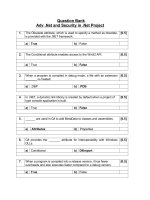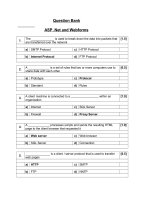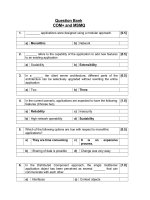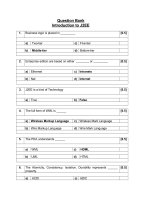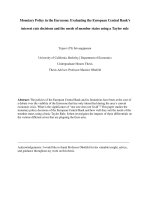Question Bank COM+ and MSMQ
Bạn đang xem bản rút gọn của tài liệu. Xem và tải ngay bản đầy đủ của tài liệu tại đây (697.02 KB, 73 trang )
Question Bank
COM+ and MSMQ
1. _________ applications were designed using a modular approach. [0.5]
a) Monolithic b) Network
2. _______ refers to the capability of the application to add new features
to an existing application
[0.5]
a) Scalability b) Extensibility
3. In a ______ tier client server architecture, different parts of the
architecture can be selectively upgraded without rewriting the entire
application
[0.5]
a) Two b) Three
4. In the current scenario, applications are expected to have the following
features (Choose two)
[1.0]
a) Reliability c) Insecurity
b) High network operability d) Scalability
5. Which of the following options are true with respect to monolithic
applications?
[0.5]
a) They are time consuming c) It is an expensive
process.
b) Sharing of data is possible d) Change was very easy
6. In the Distributed Component approach, the single middle-tier
application object has been perceived as several _______ that can
communicate with each other
[1.0]
a) Interfaces c) Context objects
b) Components d) Objects
7. The n-tier architecture talks about a logical architecture [0.5]
a) True b) False
8. In Two-tier client server architecture, the business logic has to be
present on every client.
[0.5]
a) True b) False
9. The middle tier can be hidden behind the firewall security of the
network in the two-tier architecture
[0.5]
a) True b) False
10. In Two-tier client server architecture, the _______ controls the flow of
data between the database and the application.
[0.5]
a) Client b) Server
11. In Distributed Component Approach, the interaction between
components and the environment is carried out through a Context
Object.
[0.5]
a) True b) False
12. Which of the following is true for components in a component based
approach?
[1.0]
a) They behave like a black
box hiding the
implementation from the
outside world.
c) They can be used by
locating it through its
identity.
b) They encapsulate the data
and methods.
d) They are difficult to modify
13. The components in Distributed Component Approach require a
__________ to run.
[1.0]
a) Origin Server c) Content Server
b) Application Server d) Gateway Server
14. In n-tier architecture, the factor ‘n’ depends on the number of parts the
business logic is divided into.
[1.0]
a) True b) False
15. In Three-tier architecture ________ logic is shared among clients. [1.0]
a) Presentation c) Data
b) Business d) Database
16. What are the advantages of two-tier client server architecture from the
following?
[1.0]
a) Server implements the rules
for data integrity.
c) Implementation of a powerful
hardware for the server does
not enhance the reliability of
the application.
b) It prevents different data
integrity rules being
implemented by different
client applications.
d) Implementation of a
powerful hardware for the
server enhances the
availability of the
application.
17. To support the increase in load, an application needs to be highly
________ along with the additional hardware support.
[1.0]
a) Available c) Scalable
b) Shareable d) Reliable
18. ________ is a process of hiding the details about its operations from
other layers.
[1.5]
a) Persistence c) Polymorphism
b) Security d) Encapsulation
19. Which features are necessary for large-scale, enterprise-level and
web-based applications?
[1.5]
a) Data Sharing d) Performance
b) Reliability e) All options given
c) Security
20. Which of the following is true for n-tier architecture? [1.5]
a) Due to division of
application logic into
multiple parts, scalability is
achieved.
c) More system resources are
not available to the
application.
b) The parts of the business
logic may reside on different
systems.
d) The middle tier objects are
able to communicate with
each other.
21. In three-tier architecture, the entire business logic of the application
physically resides on ________
[1.5]
a) Client and Server c) Two machines
b) Single machine d) Client, Server and Backend
22. In n-tier architecture, the number of parts obtained by dividing the
business logic are _________ on/of each other.
[1.5]
a) Independent b) Dependent
23. Which of the following are true for a three-tier client server
architecture?
[1.5]
a) The application tier can be
standardized.
c) More system resources
can be made available.
b) Large application may not
have the desired scalability
level.
d) The business logic, or the
database type or schema
can be changed without
causing interruption to the
clients.
24. The synonym for middle tier, in a three-tier client server architecture is
_________ tier.
[1.5]
a) Data c) Server
b) Client d) Application
25. Statement 1: The presentation logic and the business logic are not
bundled together.
Statement 2: New functionalities can be easily added in a two-tier
client server architecture
[1.5]
a) Statement 1 is true. c) Both statements are true.
b) Statement 2 is false. d) Both statements are false.
26. Which of the following are true for a two-tier client server architecture? [2.0]
a) There is a no distinction
between data and the
application.
c) The client machine is
responsible for processing
data.
b) The presentation logic and
the business logic are
clubbed together as a client
application
d) The client holds the
database.
27. Application architectures are part of __________ of the OSI model. [2.0]
a) Layer 2 c) Layer 4
b) Layer 3 d) Layer 7
28. Two-tiered systems can only access one database system at a time.
Other database systems, mainframe applications, or other resources
must be accessed through gateways.
[2.0]
a) True b) False
29. Which of the following are true in case of two-tiered architecture? [2.0]
a) Databases must not maintain
connections with each active
client.
c) None of the options given
b) It is difficult to reuse two-
tiered application logic
broadly, because
applications are tightly
bound to specific database
systems and table formats.
d) Databases must maintain
connections with each
active client.
30. Busy web sites typically employ two or more _______ in a load-
balancing scheme.
[2.0]
a) Clients c) Data sources
b) Web servers d) Data Servers
31. VB (Visual Basic) from Microsoft is one of the tools that competes with
a n-tier development.
[2.0]
a) True b) False
32. Which of the following is true for Data Access tier? [2.0]
a) It lies between Business tier
and Data tier.
c) It is used to provide
interfaces to the database.
b) It lies between presentation
and Data tier
d) It is used to handle data
input/output.
33. In a _______ tiered architecture, contention can occur in the database
as many clients try to work on the same data concurrently.
[2.0]
a) One c) Three
b) Two d) Layered
34. _______ computing is where remote servers and clients cooperate
over the Internet to perform tasks.
[2.0]
a) ClientCentric c) Netcentric
b) ServerCentric d) DataCentric
35. Which one of the following is true in case of a three-tier architecture? [2.0]
a) Thin client, Fat server c) Fat client
b) Fat client, Thin server d) Thin server
36. Statement1: Two-tiered security focuses on granting or denying users
access to data.
Statement 2: Three-tiered security focuses on granting or denying
access on a component-by-component basis
[2.0]
a) Statement 1 is true. c) Both statements are true.
b) Statement 2 is false. d) Both statements are false.
37. ______ is a platform-independent, distributed, object-oriented system
for creating binary software components that can interact.
[0.5]
a)
COM
c)
MOC
b)
OCM
d) DCOM
38. COM is not a ________ but a set of specifications. [0.5]
a) Distributed Technology b) Programming Language
39. Interfaces are immutable. [0.5]
a) True b) False
40. Different classes can implement the interfaces differently. [0.5]
a) True b) False
41. COM uses ________ to identify a component. [0.5]
a) Decimal Numbers b) Hexadecimal Numbers
42. Components can implement Multiple interfaces. [0.5]
a) True b) False
43. _________ is a variation of Remote Procedure Call (RPC) enabling
communication between two processes on the same machine.
[0.5]
a) PLC b) LPC
44. RPC enables applications residing on different machines to
communicate with each other using a variety of network transport
techniques.
[0.5]
a) True b) False
45. The ________ function decides whether the component supports a
particular type of interface.
[0.5]
a) QueryInterface() b)
AddRef()
46. GUID stands for Globally Unique Identifiers. [0.5]
a) True b) False
47. A GUID is a _______ value. [0.5]
a) 256-bit c) 64-bit
b) 128-bit d) 32-bit
48. S_OK and E_UNEXPECTED are some of the values of HRESULT. [0.5]
a) True b) False
49. COM architecture supports distributed objects, which enable the
method of ______ balancing.
[1.0]
a) Scale b) Load
50. Open Software Foundation defines ________ as a 128-bit number to
identify the remote systems in a distributed computing environment’s
remote procedure call.
[1.0]
a) UUID b) GUID
51. In Remote Process Server technique, the overheads in communicating
with the remote components are not high.
[1.0]
a) True b) False
52. In COM, the status of an operation is notified through the return value
of the function in a format known as HRESULT.
[1.0]
a) True b) False
53. By providing binary standard for interoperability, COM enables
applications developed by multiple developers and vendors to
communicate with each other.
[1.0]
a) True b) False
54. Which of the following are the advantages of using interfaces with
COM components?
[1.0]
a) Language dependence for
developing the componentt
c) Hidden internal
implementation of the
component.
b) Reusable application
architecture
d) Language independence
for developing the
component
55. Which of the following are true in relation with IUnknown interface? [1.0]
a) According to COM
specifications, it is mandatory
that every COM component
must support it.
d) All the functions defined in
this interface are pure virtual
functions.
b) It is available by default for all
windows based systems.
e) All of the above
c) It helps the client application to
scan for other interfaces
available in the component.
56. Which are the three functions or methods supported by IUnknown
interface?
[1.0]
a) QueryInterface() c) Release()
b) AddRef() d) AddInterface ()
57. ________ and ________are the functions used for managing the life
cycle of an object.
[1.0]
a) Release() c) QueryInterface()
b) AddInterface () d) AddRef()
58. Which of the following types of COM components depend on the type
of container chosen and the location of the component?
[1.0]
a) In-process server c) Remote server
b) Out-of-process server d) In-range server
59. The ________ function decides whether the component supports a
particular type of interface.
[1.0]
a) QueryInterface() b) AddRef()
60. In-process server is a type of COM component, which is implemented
in the form of DLL files.
[1.0]
a) True b) False
61. The features that COM provides are: [1.5]
a) Creation and use of reusable
component objects.
d) A good foundation for
security at the object level.
b) A single programming model
for developing components on
native and non-native
platforms.
e) All of the above.
c) Optimum usage of the system
resources by encapsulating
the life-cycle management of
the object internally.
62. Which are the standard interfaces to be implemented by COM that are
associated with the standard Ids and provide certain standard
functionalities shared by most of the components developed by various
component authors?
[1.5]
a) IUnknown c) IKnown
b) IUndispatch d) IDispatch
63. Which of the following are the advantages of the components created
by using COM technology?
[1.5]
a) Fully Language dependent c) Provides Location
Transparency
b) Supports version
compatibility
d) Fully Language
independent
64. Which of the following are true in relation with an interface? [1.5]
a) Defines ways in which
components will talk to each
other.
c) Through few controls of
interface, the user can use
multiple functionalities.
b) Helps in hiding the business
logic used for developing
the object.
d) Does not enable the
interaction between different
types of components of the
system.
65. Which of the following is true with regards to Interface pointer? [1.5]
a) It points to a group of pointers
wherein each pointer from the
group points to another group
of pointers.
c) It points to a group of
pointers.
b) It points to the interface
member functions.
d) Each pointer from the
group of pointers points to
the interface member
functions.
66. Which of the following are the advantages of using DLLs? [1.5]
a) The overheads involved in
memory allocation are
reduced.
d) Supports multiple
languages.
b) Does not save disk space. e) All of the above.
c) Upgradations are easy.
67. Which of the following is true for COM components in relation with
.EXE and .DLL formats?
[1.5]
a) The executable codes for the
COM objects are placed in
the .EXE format or the .DLL
format.
d) . EXE and .DLL are the file
extensions provided for the
files under Windows
operating system to identify
them as executables and
dynamic link libraries
respectively.
b) The .DLLs or .EXEs act as a
component server as they are
the means of component
distribution.
e) All of the above
c) The .EXE or .DLL files act as
containers for the COM
component.
68. Which of the following are true regarding a type of COM component
known as In-process server?
[1.5]
a) The overheads involved in
memory allocation increase.
c) Any change made to the
DLL does not require the
client applications using it
to be recompiled.
b) Same copy of DLL cannot be
shared by multiple
applications.
d) The DLL gets loaded in the
address space of the client
process itself.
69. The _________ function returns a value of type HRESULT, which is
the COM error status code with a specific format, whereas the
functions __________ and _________return ULONG i.e. unsigned
long values.
[1.5]
a) AddRef(),QueryInterface(),
Release()
c) AddRef(),Release(),
QueryInterface()
b) QueryInterface(),AddRef(),
Release()
d) Release(),QueryInterface(),
AddRef()
70. Which of the following is the structure of GUID? [1.5]
a) typedef struct _GUID { // size
is 16
DWORD Data1;
WORD Data2;
WORD Data3;
BYTE Data4[4];
} GUID;
c) typedef struct _GUID { // size
is 16
WORD Data1;
WORD Data2;
WORD Data3;
BYTE
Data4[8];
} GUID;
b) typedef struct _GUID { // size
is 16
DWORD Data1;
WORD Data2;
WORD Data3;
BYTE Data4[8];
} GUID;
d) typedef struct _GUID { // size
is 16
WORD Data1;
WORD Data2;
WORD Data3;
BYTE
Data4[4];
} GUID;
71. Statement 1: CLSID, a class ID is a GUID that names an interface.
Statement 2: IID, an interface ID is a GUID that names an interface.
[2.0]
a) Statement 1 is false c) Statement 1 is true
b) Statement 2 is true d) Statement 2 is false
72. Statement 1: CLSID is a class ID or a GUID which is used to name a
coclass.
Statement 2: IID, an interface ID is a GUID that names an interface.
[2.0]
a) Statement 1 is false c) Statement 1 is true
b) Statement 2 is true d) Statement 2 is false
73. Statement 1: There is no selective inheritance in COM; if one interface
inherits from another, it includes all the methods that the other
interface defines.
Statement 2: Inheritance in COM means only reusing code.
[2.0]
a) Statement 1 is true c) Both statements are true
b) Statement 2 is false d) Both statements are false
74. Which of the following is true in relation with namespaces for
components?
[2.0]
a) It is a named collection of
classes.
c) They reduce name collisions
between classes.
b) It is a named collection of
other namespaces.
d) All of the above.
75. __________ and __________ are the two ways of packaging
components in COM.
[2.0]
a) Hierarchical and Physical. c) Global and Local.
b) Hierarchical and Logical. d) Logical and Physical.
76. Statement 1: In COM, all communication between clients and objects
occurs over methods defined on interfaces.
Statement 2: Methods are implemented in classes, but defined on
interfaces.
[2.0]
a) Statement 1 is true c) Both statements are true
b) Statement 2 is false d) Both statements are false
77. Statement 1: HRESULT is a 32-bit signed integer with nonnegative
values indicating success.
Statement 2: HRESULT is a 32-bit signed integer with nonnegative
values indicating failure.
[2.0]
a) Statement 1 is true c) Statement 1 is false
b) Statement 2 is true d) Statement 2 is false
78. Which are the two types of inheritance used by COM+? [2.5]
a) Interface inheritance c) Data inheritance
b) Implementation inheritance d) Class inheritance
79. Which of the following are true in relation with the IUnknown interface
methods?
[2.5]
a) Release() method tells the
COM object to increment its
reference count.
d) AddRef() tells the COM
object to decrement its
reference count.
b) Release() method can be
called to tell the COM object
that it is no longer needed
e) All of the above.
c) Once Release() method is
called, we must not use the
interface pointer any more.
80. Which of the following are true with respect to COM? [2.5]
a) For COM, we can define a new
version of an old interface and
give it the same identifier.
d) In COM, interface names
usually starts with I.
b) The structure of COM
objects in memory just
happens to use the same
structure that is used by C++
virtual functions.
e) All of the above.
c) As COM is Win32-specific, it
could, in theory, be ported to
Unix or any other OS.
81. HKEY_CLASSES_ROOT key is the basic requirement of COM
components.
[0.5]
a) True b) False
82. _______ are application specific names and their corresponding
values
[0.5]
a) Sub Keys b) Named Values
83. The component ID is not stored in the CLSID key [0.5]
a) True b) False
84. In a windows registry, _______ are the keys created within a key. [0.5]
a) Sub Keys b) Default Keys
85. ______ can be a decimal number, hexadecimal number or a string. [0.5]
a) Default Value b) Named Value
86. The files generated by the MIDL (Microsoft IDL) compiler can have an
extension of .C or .H.
[0.5]
a) True b) False
87. The _______ file contains the definitions of the interfaces in C++
language.
[0.5]
a) name_I.C b) name.H
88. EDIT.EXE utility displays the windows registry contents in the Registry
Editor.
[0.5]
a) True b) False
89. The _______ file contains the proxy/stub source that is used in local
process and remote components.
[0.5]
a) name_P.C b) name_I.C
90. HKEY_CLASSES_ROOT key holds the information about all the
registered components and file associations.
[0.5]
a) True b) False
91. The _______ file contains the GUID definitions of interfaces,
components and type libraries.
[0.5]
a) name_I.C b) name.H
92. In DCOM, AppID is a sub key used for mapping a GUID to a
component on a remote server.
[0.5]
a) True b) False
93. The Windows registry, being a unified database, can store information
about the details of the users, and hardware of a system but cannot
store information about the applications installed in it.
[1.0]
a) True b) False
94. Which of the following are true with regards to Default Values? [1.0]
a) They are provided with a
specific name.
c) They are unnamed values.
b) Each key can have only one
default key.
d) Each key can have more
than one default key.
95. _________ key holds information about globally accessible data like
general configurations of the system and applications.
[1.0]
a) HKEY_CURRENT_USER b) HKEY_LOCAL_MACHINE
96. _______ are application specific names and their corresponding
values.
[1.0]
a) Sub Keys b) Named Values
97. Which of the following keys belong to Windows registry? [1.0]
a) HKEY_CLASSES_ROOTPROFILE c) HKEY_LOCAL_MACHINE
b) HKEY_CURRENT_USER d) HKEY_USERPROFILE
98. Which of the following are true with regards to the utility called
‘REGEDIT.EXE’?
[1.0]
a) It is used to view the
contents of the registry.
c) It displays the registry
contents in Registry
Editor.
b) It is not a part of Windows
Operating System.
d) It is a part of Windows
Operating System.
99. Statement 1: The name.H file contains the definitions of the interfaces
in C++ language.
Statement 2: The name_I.C file contains the GUID definitions of
interfaces, components and type libraries.
[1.0]
a) Statement 1 is true c) Both statements are true
b) Statement 2 is false d) Both statements are false
100. Which file is used as the language neutral library by the non-C++
client applications to communicate with the component server?
[1.0]
a) name_I.C b) name.TLB
101. Which are the .ini files in Windows 3.x systems that store the
information related to the system?
[1.0]
a) in.ini c) win.ini
b) system.ini d) sys.ini
102. Which of the following is a typical structure of ProgID? [1.0]
a) <Program>.<Version>.<Component>
b) <Program>.<Component>.<Version>
103. Statement 1: The DLLDATA.C file contains the proxy/stub source that
is used in local process and remote components.
Statement 2: The name_P.C file contains the code to implement the
proxy/stub DLL.
[1.0]
a) Statement 1 is true c) Statement 1 is false
b) Statement 2 is true d) Statement 2 is false
104. Statement 1: Microsoft has provided non-C++ clients with Type
Libraries, which are language independent files to help them in using
the component technology.
Statement 2: Using the type library, the non-C++ client applications
can get the type information about the interfaces and functions
supported by the component.
[1.0]
a) Statement 1 is false c) Statement 1 is true
b) Statement 2 is true d) Statement 2 is false
105. Statement 1: The problem with .ini files was that they could be lost or
corrupted at any point of time.
Statement 2: To prevent problems with .ini files that stored information
in a scattered way, Microsoft implemented the concept of registry.
[1.5]
a) Statement 1 is false c) Statement 1 is true
b) Both the statements are false d) Statement 2 is true
106. Which of the following is true regarding the Windows registry? [1.5]
a) Information is organized in a
hierarchical structure.
c) A key is the item that is
referenced by the
application.
b) Each item in the hierarchy of
information is called a key.
d) All of the above.
107. Which of the following is true regarding HKEY_CURRENT_USER
key?
[1.5]
a) Holds information about the
user who has currently logged
in.
d) Holds the data, the user is
allowed to access.
b) Stores information related with e) All of the above
profiles of user.
c) Stores information related with
application settings.
108. Which of the following are true with regard to the sub key ProgID? [1.5]
a) It is programmatic identifier
or human readable identifier
for the class ids.
c) It is not easy to understand.
b) It is the programmer friendly
format of identifying a
component.
d) To refer to a component,
many application
development tools use sub
key ProgID rather than
CLSID.
109. Consider a registry organization for Microsoft Word 2000 that has an
internal version as 9. Which of the following are true?
[1.5]
a) If the client application
needs to use the common
features of Microsoft Word,
it can use the version
independent ProgID.
c) If the client application
needs to use the common
features of Microsoft Word,
it can use the version
dependent ProgID.
b) If the client needs to use
the specific features of
Microsoft Word 2000, it
needs to check the version
of the Word 2000
component and then
connect to it.
d) All of the above.
110. Which of the following is true with regards to the Interface Definition
Language (IDL)?
[1.5]
a) a) It is used to create the
interfaces in a language
independent way.
d) Microsoft adopted the
technology of the IDL for
their Distributed Computing
architecture and added few
COM specific extensions to
support object-oriented
features of COM
b) The files created by compiling
IDL files contain the C++
equivalent interface
definitions, GUID definitions
and other details.
e) All of the above.
c) Open Software Foundation
(OSF) originally designed the
IDL for their Distributed
Computing architecture.
111. Which one of the following is the structure of the IDL file? [1.5]
a) import “abc.idl”
//Interface xyzinf
Header
[
object,
uuid(C6ED50-5E-
11d4-95A7-0000E21024),
helpstring(“xyzinf
Interface”),
pointer_default(unique)
]
//Interface xyzinf
Definition
interface xyzinf :
IUnknown
{
HRESULT Add ([in] int
x, [in] int y, [out] int* res);
};
c) import “abc.idl”
//Interface xyzinf
Header
[
object,
helpstring(“xyzinf
Interface”)
pointer_default(unique)
]
//Interface xyzinf
Definition
interface xyzinf :
IUnknown
{
HRESULT Add ([in]
int x, [in] int y, [out] int* res)
};
b) a) import “abc.idl”
//Interface xyzinf
Header
[
uuid(C6ED4D50-
5E76-11d4-95A7-
0000E2102452),
d) import “abc.idl”
//Interface xyzinf
Header
[
object,
uuid(C6ED4D50-
5E76-11d4-95A7-
helpstring(“xyzinf
Interface”),
pointer_default(unique)
]
//Interface xyzinf
Definition
interface xyzinf :
IUnknown
{
HRESULT Add ([in] int
x, [in] int y, [out] int* res);
};
0000E2102452),
helpstring(“xyzinf
Interface”),
pointer_default(unique)
]
//Interface xyzinf
Definition
interface xyzinf :
IUnknown
{
HRESULT Add ([in]
int x, [in] int y, [out] int*
res);
};
112. Consider the following IDL snippet.
import “abc.idl”
//Interface xyzinf Header
[
object,
uuid(C6ED4D50-5E76-11d4-95A7-0000E2102452),
helpstring(“xyzinf Interface”),
pointer_default(unique)
]
Which of the following are true with regard to the snippet above?
[1.5]
a) The contents within the
square brackets are a set of
MIDL attributes specifying
the characteristics of the
interface definition.
c) The attribute ‘uuid(…)’
specifies the interface ID
(IID) to be associated with
that interface.
b) The attribute ‘helpstring(…)’
indicates that the interface is a
COM interface and directs the
MIDL compiler to generate the
proxy/stub code for that
interface.
d) The attribute ‘object’
provides the description of
the interface that will be
placed in the type library.
113. Consider the following IDL snippet.
//Interface xyzinf Definition
interface xyzinf : IUnknown
{
HRESULT Add ([in] int x, [in] int y, [out] int* res);
};
Which of the following are true with regard to the snippet above?
[1.5]
a) The ‘out’ attribute informs the
MIDL compiler that the
direction of the parameter is
from the client application to
the component server.
c) The ‘in’ attribute specifies
that the direction of the
parameter is from the
component to the client
application.
b) The ‘in’ attribute ensures
that no return value is being
sent from the component to
the client through the
parameter.
d) The ‘out’ attribute ensures
that no return value is
being sent from the client
application to the
component.
114. Which of the following will be a ProgID for an application of Microsoft
Access 2000 Version 9?
[1.5]
a) Access.9.Application c) Access.Application.9
b) 9.Access.Application d) 9.Application.Access
115. Statement 1: IID stands for an interface ID.
Statement 2: IID registers new interfaces by associating an interface
name with an interface ID.
[2.0]
a) Statement 1 is true c) Both statements are true
b) Statement 2 is false d) Both statements are false
116. Which of the following is true?
Statement 1:Version Independent ProgID refers to the currently
installed version of the application's class.
Statement 2:Version Dependent ProgID refers to the currently
installed version of the application's class.
[2.0]
a) Statement 1 is true c) Both statements are true

